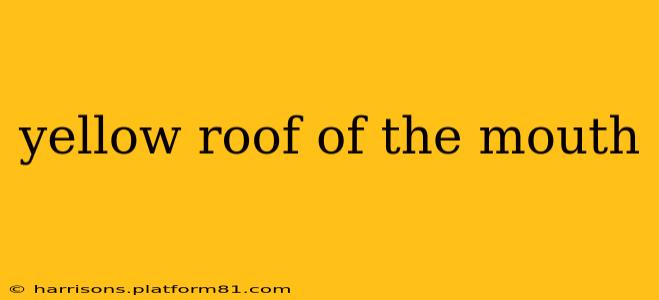A yellow roof of the mouth, or yellow palate, is not a condition in itself, but rather a symptom that can indicate various underlying health issues. The color change is often due to a buildup of substances or inflammation. It's crucial to understand the potential causes to seek appropriate medical attention. This comprehensive guide will explore the possible reasons behind a yellow palate and outline the steps to take if you experience this symptom.
What Could Cause a Yellow Roof of the Mouth?
Several factors can contribute to a yellow discoloration on the roof of your mouth. Let's delve into the most common causes:
Dehydration:
Dehydration can lead to a dry mouth, making the palate appear yellowish due to a buildup of dead cells and debris. This is often accompanied by other symptoms of dehydration like thirst, fatigue, and dark urine. Adequate hydration is key to preventing this.
Smoking and Tobacco Use:
Chronic smoking and tobacco use are significant contributors to discoloration of the mouth tissues, including the palate. The nicotine and tar in tobacco products stain the tissues, leading to a yellowish or brownish hue. Quitting smoking is crucial for improving oral health and overall well-being.
Food and Drink:
Certain foods and drinks, particularly those with strong coloring agents, can temporarily stain the palate. Curries, brightly colored candies, and even certain medications can leave a temporary yellow tint. This is usually temporary and easily resolved with good oral hygiene.
Infections:
Viral or bacterial infections in the mouth or throat can cause inflammation and discoloration of the palate. These infections might manifest with other symptoms like sore throat, fever, or swollen lymph nodes. A doctor or dentist can diagnose and treat these infections.
Oral Thrush (Candidiasis):
This fungal infection, caused by an overgrowth of Candida yeast, can appear as white or yellowish patches on the roof of the mouth. It's often associated with a burning sensation or soreness. Oral thrush requires medical treatment with antifungal medications.
Jaundice:
While less common, a yellowing of the palate can be a sign of jaundice, indicating liver problems. Jaundice causes a yellowish discoloration of the skin, whites of the eyes, and mucous membranes, including the roof of the mouth. This warrants immediate medical attention.
Medications:
Some medications can have side effects that lead to changes in the color of the mouth tissues. Always consult your doctor or pharmacist if you suspect a medication might be causing discoloration.
What are the symptoms associated with a yellow roof of the mouth?
The symptoms accompanying a yellow palate vary greatly depending on the underlying cause. It's important to pay attention to other accompanying symptoms:
- Pain or discomfort: Is the yellowing accompanied by pain, burning, or soreness?
- White patches: Are there any white patches along with the yellow discoloration?
- Fever or chills: Are you experiencing fever, chills, or other signs of infection?
- Changes in urine or stool color: Is your urine darker than usual or your stool lighter?
- Yellowing of the eyes or skin: Have you noticed yellowing in other parts of your body?
When should I see a doctor about a yellow roof of the mouth?
If the yellowing of your palate is accompanied by any of the symptoms mentioned above, especially pain, fever, or yellowing of the skin or eyes, it's crucial to consult a doctor or dentist immediately. A persistent yellow discoloration, even without other symptoms, warrants a check-up to rule out any serious underlying conditions.
How is a yellow roof of the mouth treated?
Treatment depends entirely on the underlying cause. Temporary staining from food or drink typically resolves on its own with good oral hygiene. Infections require medical treatment with antibiotics or antifungals. Underlying medical conditions such as jaundice require specialized medical care.
Can I prevent a yellow roof of the mouth?
Practicing good oral hygiene, including regular brushing and flossing, can significantly reduce the risk of discoloration. Maintaining a healthy diet, staying hydrated, and avoiding smoking and tobacco products are also essential preventative measures.
This information is for general knowledge and informational purposes only, and does not constitute medical advice. It is essential to consult with a healthcare professional for any health concerns or before making any decisions related to your health or treatment.
